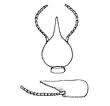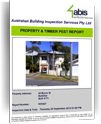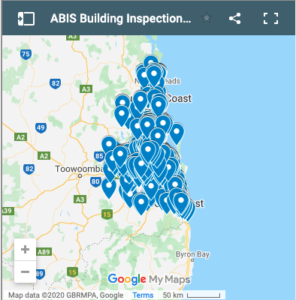Nasutitermes spp. are multi-site nesters characterised by soldiers with nasute heads tapering to a long snout. Soldiers are smaller and more fragile than workers. In contrast, workers are arched and more heavily built in the front section. They also have two dark areas on the top of the head. Colonies contain a queen, king, soldiers, workers, and reproductives.
Nasutitermes exitiosus: are located in southern Queensland to New South Wales. This is a mound-building species, except in drier areas, where it nests in tree stumps or below ground, often leaving bare earth above it. It is capable of extensively damaging hardwood timber structures specifically attacking wood in the ground and sound wood in buildings. It builds its nests under properties and unless the subfloor area is inspected regularly the colony can go unnoticed until flooring collapses. Wooden bridges, poles and fences are also severely damaged by this species. Pine timbers are resistant to these species and where attack is present, hardwood timbers, particularly its sapwood is preferred. Their mounds are usually dome shaped, 30 to 75 cm high with a basal diameter of 30-120cm. When the nest is prised up at ground level, there is usually a physogastric queen measuring 25-30mm. Soldiers are generally 3.6 to 4.8mm.
Nasutitermes fumigatus: attacks decaying wood in contact with ground. Where decay has occurred to flooring timbers in a property, due to poor ventilation, these termites will damage the wood, making replacements necessary. They will also attack moist and weathered decking on outside verandahs. However, they do not attack sound structural timbers in well ventilated situations. Their colonies are small and soldiers are generally 3.25 to 3.75 mm. Generally they are non-mound builders.
Nasutitermes walkeri : has the largest soldiers (5 to 7 mm) and is encountered in coastal bushland from Sydney to Cairns, where it constructs characteristic arboreal nests. Colonies appear in the root crowns of trees where there is decay or fire damage. When the colonies are well established and numbers large, they construct arboreal nests higher up the trees but maintain soil contact with galleries extending down the tree trunk. The outside casting of their nest is soft and friable, easily broken and penetrated. The arboreal part of the nest is often connected to another part of the colony in the root crown area or another subterranean part of the tree. The connection between the two sections is both internal and external. Shelter tubes are dark brown to black and often seen on the outside of the tree trunk. Nests are large and populous. Subterranean tunnels just below surface level radiate from the base of the tree to various food sources. Although damage may be done to fences, poles and wood in the ground, attack of buildings is associated with decaying wood and high moisture.


Nasutitermes Summarised

Type: Subterranean
Family: Termitidae
Sub-Family: Nasutitermitinae
Genus:
- centraliensis
- longipennis
- coalescens
- smithi
- eucalypti
- triodiae
- exitiosus
- kaewiengensis
Identification:
Soldier 4.2 mm. Head drawn back into beak with no mandibles and not constricted near its centre when viewed from above.
Castes:
- Queen
- King
- Soldier
- Worker
- Reproductive
Nest types: Dome shaped ground mounds 30 – 75 cm
Significance: Damage to wood in ground and also sound wood in buildings where it may go undetected. Wooden bridges, poles and fences also are severely damaged.
Nasutitermes walkeri constructs an arboreal nest but maintains soil contact with galleries extending down the trunk of the trees. Nests are found commonly on ironbark and stringybark trees, as well as tallowwood (Eucalyptus microcorys). Soldiers are 5-7 mm long. This species feeds on dead wood and can attack decayed and weathered timber. Kingfishers and lizards use the arboreal nests as temporary residences. Nasutitermes graveolus occurs in coastal and nearby districts from Townsville to Darwin. It constructs a dark, almost spherical arboreal nest of a light brittle carton material. This species can attack fence posts and transmission poles, but the damage is usually slight. Nasutitermes exitiosus constructs low mounds and attacks wood in the ground and also sound wood in buildings. Wooden bridges, poles and fences are also severely damaged by this species. Principally, however, it is a pest in southern states and is rarely found in the Brisbane region, which is near the northern extent of its range. These 3 species of Nasutitermes feed on hardwoods only.
Nasutitermes magnus makes irregularly shaped mounds which may reach a height of 2 m around Brisbane. It is a grass feeder.




